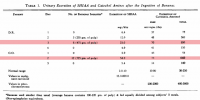Travis
Member
- Joined
- Jul 14, 2016
- Messages
- 3,189
Well, it could depend on the intestinal enzyme and gut permeability. If one hundred people eat ¹⁄₂# of cheese,* you would expect different levels of β-casomorphin in the cerebospinal fluid. These peptides are buried withing a protein over 200 amino acids long, and their are many potential factors involved: Some bacteria in the intestines have enzymes which can help break proteins into less bioactive fragments, but some people have taken long‐term antibiotics—potentially destroying this bacteria. The amount of trypsin and pepsin in the intestines would also play a role as well as stomach pH.The opiate effects of wheat and dairy goes very well with a lot of the issues I have experienced. If dairy is so good for bone growth then perhaps having smaller amounts of goat cheese would be good for long term health.
Do you have any idea why some people react much more to dairy than others? Have thyroid function and overall metabolism anything to do with it?
But if someone eats dairy every day and has done so for decades, would you really expect them to know how it effects them? Chronic food eating establishes a new baseline, and even feeling like total crap can become the norm. I think the most reliable way to determine if β-casomorphin or gluten exorphin B5 is having an effect is to stop eating these foods for weeks, and then perhaps eating them again. I think I can feel the effects of β-casomorphin, and I don't think it's an immunogenic response to the protein. Eating cheese for me feels quite a bit different than eating anything else.
[*] Eating this much cheese is possible, and I can prove it.

